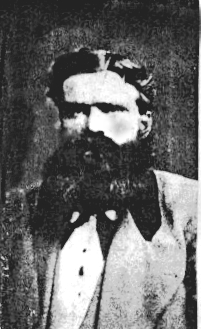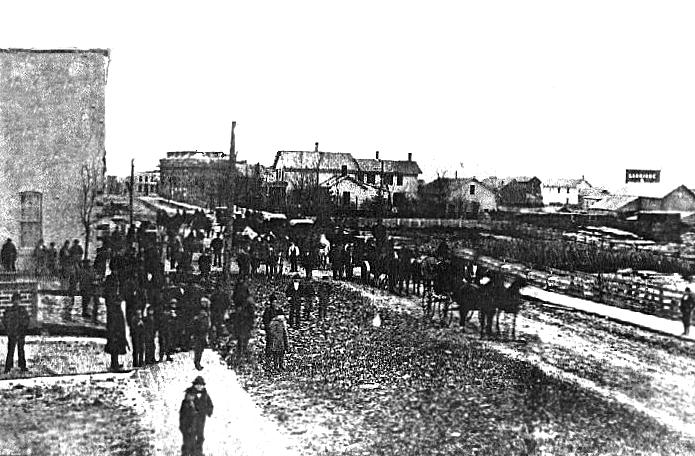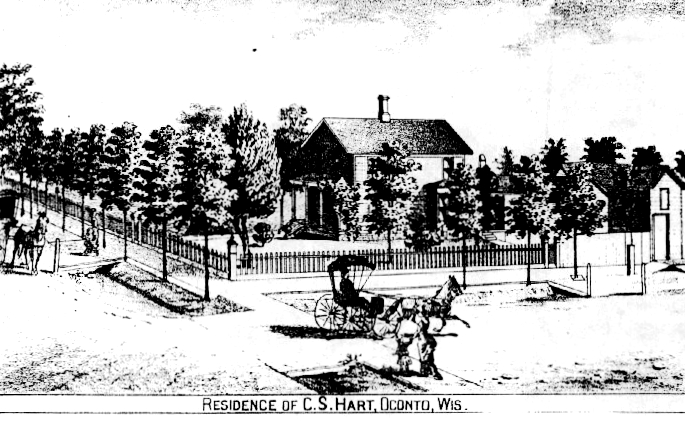| Oconto County Reporter
Thursday, November 11, 1971 Contributed by Dave
Cisler
A page in Oconto County History 1875 FIRE FIEND!
Thus ran the Reporter headlines in the August 4, 1875, issue, in one of the biggest stories of the year. “Again we are called upon to chronicle the visitation of another conflagration in our city, sweeping away in a few moments property that has taken years to accumulate,” began the account of the fire that turned the east end of Main street to ashes. Gone up in flames were the Revere House, the store buildings of Messrs, Frey and Royce, a smithy, carriage shop, Reinhart’s barn, and the dwelling of E. C. Classon. The paper noted that the fire had started at three o’clock in the morning (the hour that most of the fires in business places seemed to start) and, as always, there were rumors of arson. In his continuing diatribe against the state of the town’s fire protection, Editor Hart railed: “It is no thanks to the fire department that the whole east end of the city was not burned out. The muttered curses against the criminal neglect of not replacing those rotten, worthless hoses was loud and deep.” Apparently his complaint this time had some effect,
for soon after the council called a special meeting to discuss the purchase
of 2,000 feet of new hose.
A second major news story of the year was the elaborate funeral Wal Phillips staged for his horse. Under a dateline of November 27, 1875, the story read: “On Monday last, our attention was attracted by the distant sound of a band of music approaching our office and, as it passed, our astonishment was not a little at discovering the nature of the affair. The band was followed by a wagon ladened with a handsome square of large dimensions, fashionably decorated with silver mountings and drawn by four horses. Then followed some 20 teams, ladened with probably 100 persons. It was nothing more or less than a horse funeral, and the subject, W. W. Phillips’ old gray ‘Rob’ who departed this life on that morning. “This was Mr. Phillips’ favorite horse, and one he owned for over 20 years. The procession, after passing through the principal streets, halted in the rear of Phillips’ barn on Oconto street and the coffin was duly deposited in a grave. A funeral oration was pronounced over the remains, selling of a well-spent life and past usefulness. A striking feature in the procession was Rob’s mate, decorated in crape, and closely following the coffin.” In 1875, the Turnverien Society built its first hall on the location of the present Great Lakes Shoe Company and announced a grand opening ball to be held on Thanksgiving. Up river, the Doyle Hotel was built at the junction of the Oconto and Little Rivers in Couillardville, and William Eggert also began a grist mill in that location. About four miles out of town on the river road, Mr. Cook (father of the “Cook Bros.”, Wallace and Wilbur) began the nursery that was to become noted throughout the state, on what is now the Harold Jacquart farm. And along the bay shore, the fishermen formed their own village and, under the leadership of Louis Reed, started a school near the City Park (then called Warner’s Grove). In 1875 there were 32 schools in the county, with a total of 892 pupils enrolled, including six in Oconto – five public and the new parochial school of St. Joseph’s parish. The others in town were the Washington school on Michigan and School streets, the Lincoln school on Jones and Adams; Jefferson school on Second street; Pecor school on Center street, and the Douglas school on the southwest corner of Messenger and Gale. Two of these buildings are still standing and are now
homes – the Lincoln school (just west of the present school house on Adams
street) and the Pecor school, which was made into two Center street homes.
SAWDUST – 1875 JANUARY 9, 1875 – Fire broke out last night in the paint shop of H.L. Tibbetts on Superior near the Holt Lumber Company and soon spread to the harness shop of Frank Fisher, reducing it to ashes in minutes. Jacob Spies’ home and meat market and the boarding house of Holt and Balcom caught fire several times, but were saved. Fire Company No. 2 wishes to thank the ladies who furnished them with hot coffee. JANUARY 16, 1875 – OLD SETTLERS SUPPER – The “Oldest Lady Inhabitants”, the very first to settle here, which was upwards of 20 years ago or more, have concluded to give a supper at the Music Hall on Tuesday. When these old settlers first made their homes here, the forest extended to either bank of the Oconto river, where flourished an Indian village of 1,000 souls. That was in 1852. The “Old Lady Settlers” are Mrs. Lindsey, Mrs. Barnard, Mrs. Hart and Mrs. McDonald. They represent the four pioneer families who first settled in Oconto. FEBRUARY 20, 1875 – On Monday three men started from Mrs. Sweet’s logging camp on the north branch and, between Stiles and Little River, one of them became much fatigued and was obliged to rest so frequently that the other two came on and left him to get home as best he could. When his companions arrived in town, they reported the circumstances to Sam Brazeau who immediately hitched up his horse and started up river. He found the unfortunate man about midnight so completely benumbed and fatigued he was unable to help himself. Had it not been for Mr. Brazeau he would have been frozen to death. MAY 18, 1875 – IMPROVEMENT – Everybody and his nearest neighbor are hard at work laying out gardens, rebuilding sidewalks, transplanting trees and generally sleeking up around their dwellings. This is as it should be, and we are in hopes to see more of this spirit among our citizens. Every shade tree and flower adds beauty to our city. JULY 3, 1875 – Our city fathers should see that the necessary crosswalks are constructed at the intersecting of different streets with Section street (Park Avenue). An accident of grave nature may happen any dark night at the crossing of Oconto street (Congress) where it intersects with Section street, as there is a descent of nearly three feet where the end of the sidewalk abruptly terminates. At the bottom of this descent is a ditch filled with stagnant water, roots and filth. JULY 24, 1875 – OPENING OF THE BEYER HOUSE – This new
hotel was opened to the public Thursday. The house is conveniently
located and being entirely new, well furnished and presided over by James
S. Dolan, it cannot help but become a very popular hotel.
AUGUST 7, 1875 – The county is infested with burglary
and incendiary. A good watch should be kept and these inhuman fiends,
if detected, should be strung up to the first convenient place that offers.
SEPTEMBER 11, 1875 The Notre Dame school which opened
last year appears to be gaining more pupils each day. The sisters
give instruction in all the branches of an English education, and drawing,
painting and bookkeeping. The music sisters are unsurpassed in the
state, and it is needless to speak of their instruction in needlework as
they have a worldwide reputation in these branches.
DECEMBER 18, 1875 – The wholesale slaughter of deer
hunted with dogs is attracting the attention of the good citizens of this
county to the degree that petitions to the state legislature are in circulation
to pass an act to prevent their entire destruction. Organized bands
of hunters, with packs of hounds that have no regard for the preservation
of game, are killing hundreds of deer and shipping them out of the county.
At last our Maple Valley friends have a genuine post office in their neighborhood. Mr. George Trecanen has received the appointment of postmaster. We hope our town of Oconto friends will go and do likewise. You can have a post office merely for the asking, and no doubt but that Mr. J. W. Couillard would give his services gratuitously and his store would be a central position. It is harder to keep track of the sermon when you sit in back of the church, but then you get out first and have the best chance to select a good umbrella from the pile at the door. It is fun to stand on a street corner on a fine afternoon
and watch the men all rushing around trying to make money and the women
floating around trying to spend it.
|



